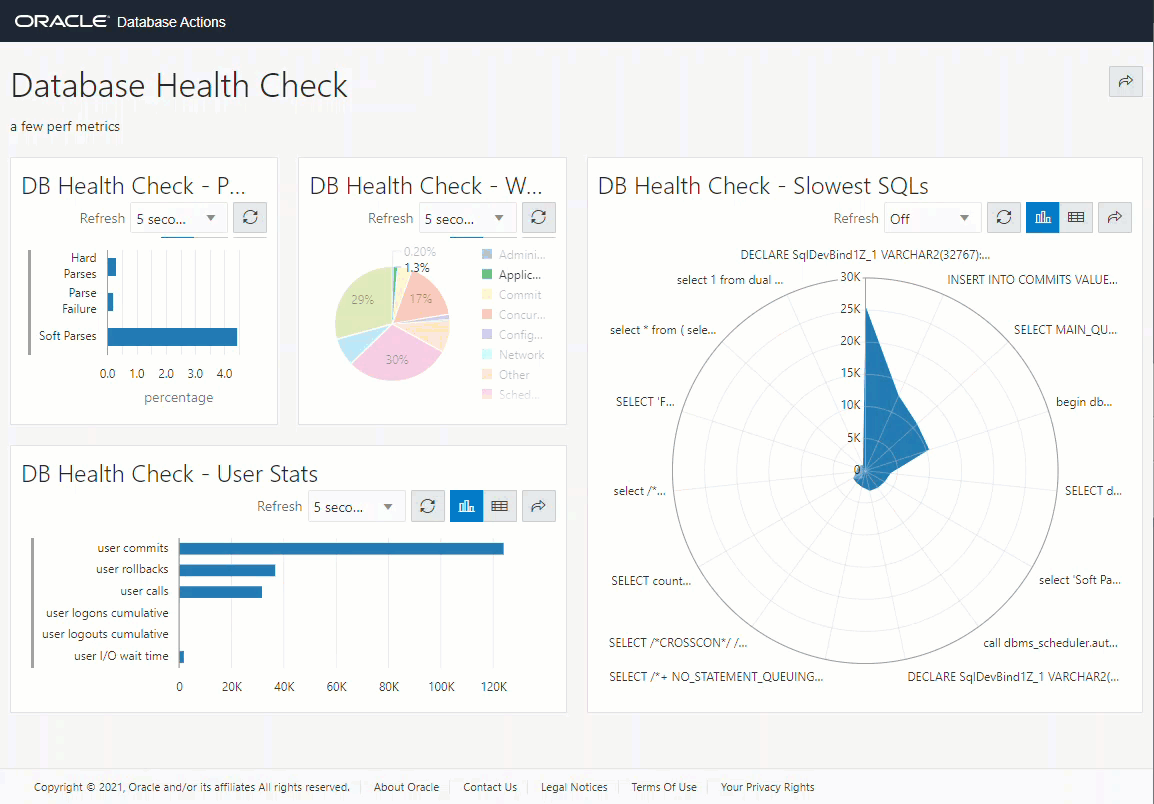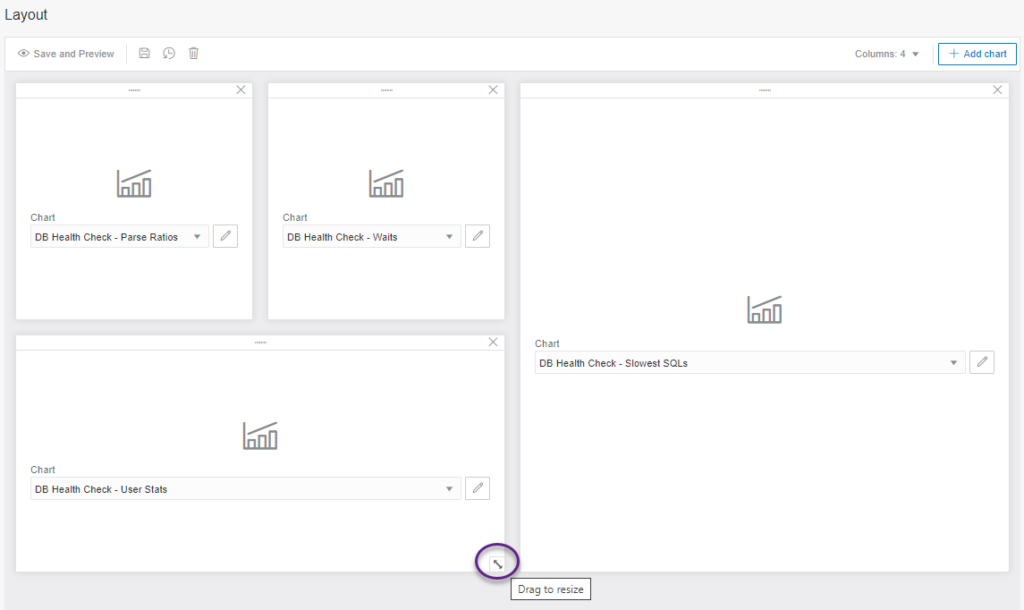Yesterday I shared a dashboard I published in my Always Free Autonomous Cloud Service.
The first question I got was:
I was just a little surprised that the examples in your blog weren’t live. After all, that’s the point of the feature.
A fan
So sure, let’s use the database itself to build some ‘live’ charts, or charts that have frequently changing data.

The Dashboard
There are 4 actual charts. The layout is very much up to you. I wanted something wide enough that I could read the SQL text on my ‘Slowest SQL’ chart. And I needed similar to get true idea of scale on my User Stats – so both of those got the space that 2 charts would normally take. And my Health Check chart isn’t just two columns wide, it’s also two columns tall!
This is how that looks in ‘design-mode:’

The Reports
I picked some easier to get metrics out of some existing SQLDev reports. I know also back in the day that Tom was quite keen on knowing what your Hard/Soft parse ratios were. Please don’t take these as endorsements by me.
I am merely trying to demonstrate what you can do with the Charts feature, and using some data out of the data dictionary.
Waits
SELECT gv$system_event.wait_class AS wait_class, 0.6 * SUM(gv$system_event.time_waited) AS time_waited FROM gv$system_event WHERE wait_class != 'Idle' GROUP BY gv$system_event.wait_class ORDER BY 1
Choose whichever type of chart you want, or adjust these queries as YOU see fit.
Slowest SQL
SELECT DISTINCT sql_text AS SQL, CASE WHEN cpu_time < 1000 THEN '< 1 ms' WHEN cpu_time < 1000000 THEN to_char( round( cpu_time / 1000, 1 ) ) || ' ms' WHEN cpu_time < 60000000 THEN to_char( round( cpu_time / 1000000, 1 ) ) || ' s' ELSE to_char( round( cpu_time / 60000000, 1 ) ) || ' m' END AS cpu_seconds_form, cpu_time / 1000 AS cpu_mseconds, sql_id FROM gv$sql WHERE cpu_time <> 0 ORDER BY 3 DESC fetch FIRST 15 ROWS ONLY
I have (2) columns in the query used for the chart and the rest that come in handy if you switch to the grid view (cpu_seconds & sql_id).
User Stats
SELECT NAME, VALUE FROM V$SYSSTAT WHERE CLASS = 1 AND ( NAME LIKE 'user %' )
Boring query, but interesting data?
Parse Ratios
SELECT 'Soft Parses ' "Ratio" ,round( ((SELECT SUM(VALUE) FROM v$sysstat WHERE name = 'parse count (total)') - (SELECT SUM(VALUE) FROM v$sysstat WHERE name = 'parse count (hard)')) /(SELECT SUM(VALUE) FROM v$sysstat WHERE name = 'execute count') *100,2) "percentage" FROM dual UNION SELECT 'Hard Parses ' "Ratio" ,round( (SELECT SUM(VALUE) FROM v$sysstat WHERE name = 'parse count (hard)') /(SELECT SUM(VALUE) FROM v$sysstat WHERE name = 'execute count') *100,2) "percentage" FROM dual UNION SELECT 'Parse Failure ' "Ratio" ,round( (SELECT SUM(VALUE) FROM v$sysstat WHERE name = 'parse count (failures)') /(SELECT SUM(VALUE) FROM v$sysstat WHERE name = 'parse count (total)') *100,2) "percentage" FROM dual
That last query courtesy of dilipdba.
To create these charts, you can copy and paste the SQL in, and then go from there. Enjoy!









5 Comments
Well say we have diff client data in the table CLIENT_SALES with a CLIENT_CODE column that defines the data for each client then we have a USERS table with USER_ID and CLIENT_CODE
So in order that the dashboard only displays data for user logged in we would have
SELECT sum(cs.sales_total)
from CLIENT_SALES cs,USERS u
where u.client_code = cs.client_code
and upper(u.user_id) = :APP_USER
I’ve tried various links with logins on the underlying tables but still stuck
‘Various things’ … like, what?
These are great !
is there anyway we can link them to the current logged in user on APEX the :APP_USER ??
How do you mean, ‘link?’